by Paul Gilster | Nov 14, 2018 | Exoplanetary Science |
The detection of a planet around Barnard’s Star really hits home for me. No, this isn’t a habitable world, but the whole topic of planets around this star has resonance for those of us who remember the earliest days of exoplanet study, which could be extended back to Peter van de Kamp’s work at Swarthmore’s Sproul Observatory in Pennsylvania. The astronomer thought he had found evidence for a 1.6 Jupiter mass planet in a 4.4 AU orbit there, based on what he interpreted as telltale wobbles in photographic plates of the star taken between 1916 and 1962.
This work, ending in the early 1970s, turned out to be the result of errors in the instrument van de Kamp was using, but the buzz about possible planets around Barnard’s Star had been sufficient to create a small crest of enthusiasm for exoplanet studies in general. The British Interplanetary Society saw in Barnard’s Star a target worth investigating, and designed their Daedalus star probe around a mission there. In any case, van de Kamp’s assumption that planetary systems were common has been proven out, and now we do have a planet around this star, though not the one that the Swarthmore researcher thought he had found.
What Guillem Anglada-Escudé (Queen Mary University, London) and Ignasi Ribas (Institute of Space Studies of Catalonia and the Institute of Space Sciences, CSIC in Spain) have uncovered is a super-Earth in an orbit near the star’s snowline. From the paper in Nature:
Here we report that the combination of numerous measurements from high-precision radial velocity instruments reveals the presence of a low-amplitude but significant periodic signal at 233 days. Independent photometric and spectroscopic monitoring, as well as the analysis of instrumental systematic effects, show that this signal is best explained as arising from a planetary companion. The candidate planet around Barnard’s star is a cold super-Earth with a minimum mass of 3.2 Earth masses orbiting near its snow-line.
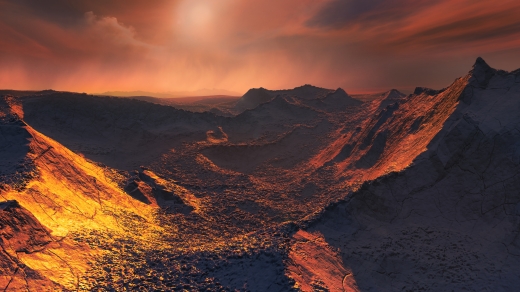
Image: An artist’s impression of the surface of Barnard’s Star b. Credit: ESO – M. Kornmesser. Licence: Creative Commons with Attribution, https://creativecommons.org/licenses/by/4.0/
Barnard’s Star b thus becomes the second closest known exoplanet to Earth (although bear in mind that the search for planets around Centauri A and B continues, as does examination of Proxima Centauri for other planets beyond Proxima b). The snow-line at Barnard’s Star, where volatiles like water can condense into solids, is close to the planet’s orbit at 0.4 AU, a reminder that the host is a red dwarf that provides but 2% of the energy the Earth receives from the Sun. The scientists believe the temperature of Barnard’s Star b would be in the range of -150 ?.
The new planet’s position in relation to the snow-line is itself interesting, as the paper notes:
The candidate planet Barnard’s star b lies almost exactly at the expected position of the snow-line of the system, located at about 0.4 au. It has long been suggested that this region might provide a favourable location for forming planets, with super-Earths being the most common planets formed around low-mass stars. Recent models incorporating dust coagulation, radial drift, and planetesimal formation via the streaming instability support this idea . Although this has yet to be shown to be part of a general trend, observational evidence would significantly constrain theories of planetary migration.
The authors point out that the Barnard’s Star work “…pushes the limits of the radial velocity technique into a new regime of parameter space,” comprising our ability to detect super-Earths in much wider orbits than ever before. Until now, such a detection would have been a matter for gravitational microlensing, with the attendant problem that such studies are inherently one-off affairs, depending on chance celestial alignments. Now we learn of a serious leap forward for radial velocity studies, one that highlights what a tricky catch this was.
Consider the range of instruments involved, among them the European Southern Observatory’s HARPS (High Accuracy Radial velocity Planet Searcher) and UVES (Ultraviolet and Visual Echelle Spectrograph) spectrographs. Says Anglada Escudé:
“HARPS played a vital part in this project. We combined archival data from other teams with new, overlapping, measurements of Barnard’s star from different facilities. The combination of instruments was key to allowing us to cross-check our result.”
All told, data from seven different instruments were put into play, a total of 771 measurements covering 18 years in a collaboration organized by the Red Dots project, which searches for terrestrial planets in warm orbits around the red-dwarf stars closest to the Sun. It was the Red Dots collaboration that was responsible for the discovery of Proxima Centauri b in 2016.
In addition to HARPS and UVES, the work included data from HIRES (High Resolution Echelle Spectrograph) at the Keck 10-meter telescope; PFS (Planet Finder Spectrograph) at the Carnegie’s Magellan 6.5-m telescope; APF (Automated Planet Finder) at the 2.4-m telescope at Lick Observatory; and CARMENES (Calar Alto high-Resolution search for M dwarfs with Exoearths with Near-infrared and optical Échelle Spectrographs) at the Calar Alto Observatory. Further observations were made with the 90-cm telescope at Sierra Nevada Observatory, the 40-cm robotic telescope at SPACEOBS (San Pedro de Atacama Celestial Explorations), and the 80-cm Joan Oró Telescope of the Montsec Astronomical Observatory (OAdM).
I don’t usually list every last instrument used in a particular detection, but I did so here because it’s a measure of what it took to find a planet of this size in a relatively cool orbit. Consider this: The data show that Barnard’s star is approaching and moving away from us at about 1.2 m/s, which is roughly the speed I make when out for my morning walk. This tiny motion detected through Doppler methods is at the heart of the new planet’s detection. The researchers note that further observations are still necessary and are underway:
“After a very careful analysis, we are over 99% confident that the planet is there, since this is the model that best fits our observations,” says Ignasi Ribas. “However, we must remain cautious and collect more data to nail the case in the future, because natural variations of the stellar brightness resulting from starspots can produce similar effects to the ones detected.”
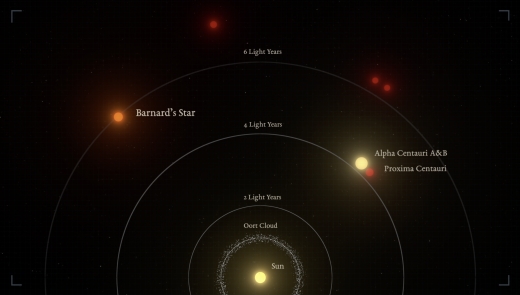
Image: Graphic representation of the relative distances to the nearest stars from the Sun. Barnard’s star is the second closest star system, and the nearest single star to us. Credit: IEEC/Science-Wave – Guillem Ramisa Licence: Creative Commons with Attribution, https://creativecommons.org/licenses/by/4.0/
Barnard’s Star is surely in our future if we reach the stage of sending instrumented probes to other stellar systems. At 6 light years, it is our closest target after the Alpha Centauri stars, and has been famous since its 1916 discovery for its remarkable proper motion of 10.3 arcseconds per year relative to the Sun. What that means is that from our perspective on Earth, this star moves faster against the background stars than any other, covering a distance equivalent to the Moon’s diameter across the sky every 180 years. In comparison to younger M-dwarfs, it is relatively quiet in terms of flare activity. Thought to be about twice the age of our Sun, it’s a reminder of our own star’s position among many stars much older than our Solar System.
The paper is Ribas, Anglada Escudé et al., “A super-Earth planet candidate orbiting at the snow-line of Barnard’s star,” Nature 15 November 2018.

by Paul Gilster | Nov 13, 2018 | Exoplanetary Science |
When astronomers talk about metals, they’re using the term in a specific sense. A metal in stellar terms is any element heavier than helium. Thus iron, silicon, magnesium and carbon qualify, all elements that are components of small, rocky planets. It was iron that John Michael Brewer (Yale University), Debra Fischer and colleagues singled out as a proxy in their recent work on the metal content of exoplanet systems. The work focuses specifically on compact, multi-planet systems as one of several system architectures found in close orbit of a host star.
What’s interesting here is that these domains seem mutually exclusive, or almost so. Unlike our Solar System, a system with multiple planets on tight orbits can squeeze its worlds into a region as close as Mercury. Likewise near the host star, we sometimes find massive planets in close orbits, known as ‘hot Jupiters.’ Few of these have close planetary neighbors, and few compact multi-planet systems have massive planets.
And there is another distinguishing factor. Where the relatively uncommon hot Jupiters appear, they are most numerous around stars with high metallicity, whereas small worlds appear around stars with a wide range of metallicity. Do systems lighter in metals have problems creating larger planets? The jury is still out, but some studies have made an association between low metallicity and small planet formation that Brewer and Fischer now strengthen in this new work.
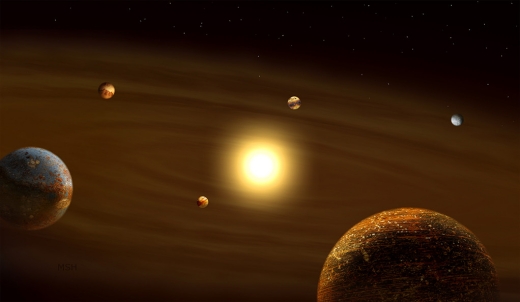
Image: Artist’s conception of a compact multi-planet system. Credit: Michael S. Helfenbein.
The researchers compared systems of a particular architecture to all known planet hosts as a function of metallicity, adding in a third architecture, systems with cool Jupiters (orbiting further than 0.3 AU from the host star). They identified in their sample 104 hot Jupiter systems, 87 cool Jupiter systems and 105 compact multi-planet systems. The latter were defined as systems with three or more planets orbiting closer than 1 AU. Note that only one hot Jupiter system is found in a compact multi-planet system, while nine cool Jupiters are found in compact systems.
The abundance of compact, multi-planet systems around stars of low metallicity that emerges is clear and points in interesting directions. Many more of these systems may exist than we have assumed. Bear in mind that such worlds are a tricky catch for radial velocity methods, but because they tend to be co-planar, they can be spotted in transit searches, which can observe transits of multiple worlds. We seem to be in a very early phase of compact system detection.
It was Fischer who demonstrated over a decade ago that higher metallicity stars were the most likely to form large gas giants, in work that supported the core accretion model of gas giant planet formation. But smaller systems have been more difficult.
“Our surprising result, that compact systems of multiple, small planets are more likely around lower metallicity stars suggests a new, important clue in understanding the most common type of planetary system in our galaxy,” said co-author Songhu Wang, a 51 Pegasi b Fellow at Yale.
Standing out in this work is the apparent connection between iron and silicon. The researchers found a high silicon-to-iron ratio in stars with lower metallicity. Moreover, low-metallicity stars are long-lived, offering older, potentially habitable worlds whose longevity may make them prime targets for astrobiology. We are likely to learn that such systems are common. From the paper:
Stars of lower metallicity and higher Si/Fe [silicon to iron] ratios are generally older or members of the galactic thick-disk population (Kordopatis et al. 2015). This could point to a changing mix of planet architectures based on formation time and location. In fact, one of the oldest verified and low-metallicity planet hosts, Kepler-444, is home to a compact multi-planet system (Campante et al. 2015). New high-precision radial velocity surveys looking for Earth-massed planets (Jurgenson et al. 2016; González Hernández et al. 2017) may find a much larger population of small planets around these lower-metallicity stars.
Fischer, in this Yale University news release, likens the ratio of silicon to iron to a “thermostat for planet formation. As the ratio increases, nature is dialing up the formation of small, rocky planets.”
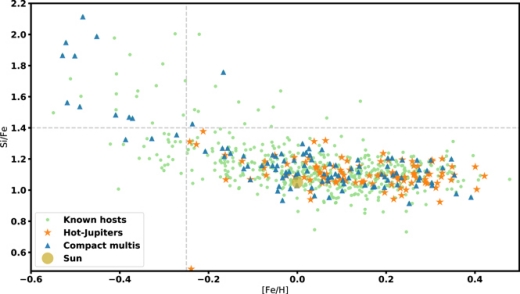
Image: This is Figure 2 from the paper. Caption: Stars with low metallicity or a high ratio of Si/Fe do not seem to form hot Jupiters, and are increasingly likely to host compact multi-planet systems. Plotted here are planet-hosting main sequence stars from our sample (green points), comparing the Si/Fe ratio to the log solar relative iron abundance, [Fe/H], with hot Jupiters (orange stars) confined to the lower right-hand side of the plot and compact multi-planet systems (blue triangles) making up a large fraction of the upper-left region. The Sun (yellow circle) is plotted for reference and the dashed lines are drawn to highlight the different populations. Stars with both high Si/Fe and high [Fe/H] are thought to be from the galactic thick-disk and are poorly represented in most planet search samples due largely to their greater distance. Credit: Brewer et al.
Exciting stuff, because we are moving into an era when new instruments like the Extreme Precision Spectrometer (EXPRES) developed by Fischer’s team at Yale, not to mention next-generation ground- and space-based resources, will make it more likely that we can find compact multi-planet systems where no transits occur.
The paper is Brewer et al., “Compact Multi-planet Systems are more Common around Metal-poor Hosts,” The Astrophysical Journal Letters Vol. 867, No. 1 (24 October 2018). Full text. Also note Zhu, “Influence of Stellar Metallicity on Occurrence Rates of Planets and Planetary Systems,” submitted to The Astrophysical Journal Letters, which likewise finds multi-planet systems more common around lower-metallicity stars (preprint).

by Paul Gilster | Nov 12, 2018 | Outer Solar System |
Extended operations at multiple targets, as Dawn showed us, are possible with ion propulsion. But we still learn much from flybys, something New Horizons reminded us with its spectacular success at Pluto/Charon, and again reminds us as it closes on MU69. Likewise, a mission called Lucy will visit multiple objects, using traditional chemical propulsion with gravity assist to achieve flybys of seven different targets. The destination: Jupiter’s trojan asteroids. With launch scheduled for 2021, Lucy’s will study six Jupiter trojans and one asteroid in the Main Belt.
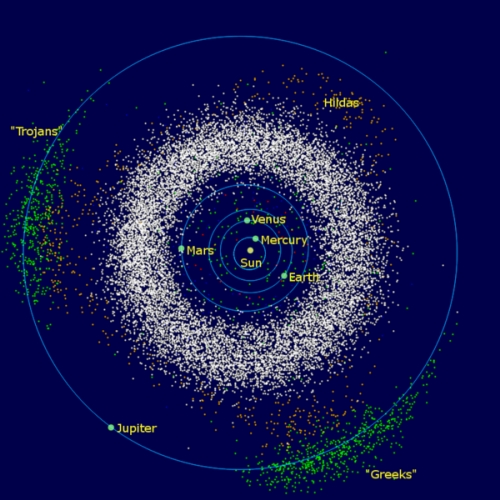
Image: Jupiter’s extensive trojan asteroids, divided into ‘Trojans’ and ‘Greeks’ in a nod to Homer, but all trojans nonetheless. Credit: “InnerSolarSystem-en” by Mdf at English Wikipedia – Transferred from en.wikipedia to Commons. Licensed under Public Domain via Commons.
The trojans are interesting bodies orbiting at the L4 and L5 Lagrange points 60° ahead and behind the gas giant. Jupiter’s trojans are the best known but the term is generic — Neptune has trojans, as does Mars, Uranus and even the Earth (2010 TK7). In fact, some Solar System moons themselves have trojans, as we saw recently when discussing Saturn’s moon Dione, which has the trojans Helene and Polydeuces. Saturn’s moon Tethys also has two trojans.
But as befits Jupiter’s massive size, it’s associated with over 6000 trojans already identified, and a larger population perhaps reaching as high as one million objects over a kilometer in diameter. 617 Patroclus is a particularly intriguing object, a D-type asteroid thought to have water ice in its interior. This object is actually a binary, with a moon named Menoetius slightly smaller than the primary. But we have C- and P- type asteroids in these Lagrange points as well, and Lucy will give us a view of each type as it makes its way into both clusters of Trojans.
The assumption is that the Jupiter trojans are remnants of primordial planet-building material, with clues to the Solar System’s formation and possibly the origins of organic material on Earth. While C-type asteroids are primarily found in the outer regions of the Main Belt, the darker P- and D-type objects have similarities to Kuiper Belt objects beyond the orbit of Neptune. Evidently abundant in dark carbon compounds, all are thought to be rich in volatiles.
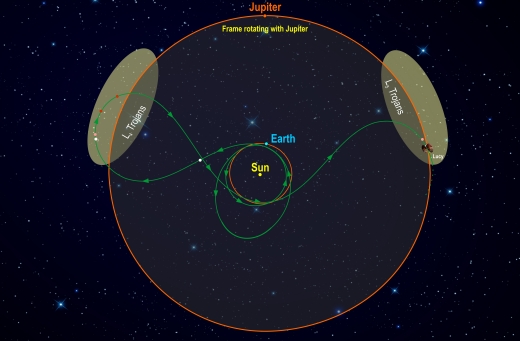
Image: This diagram illustrates Lucy’s orbital path. The spacecraft’s path (green) is shown in a frame of reference where Jupiter remains stationary, giving the trajectory its pretzel-like shape. After launch in October 2021, Lucy has two close Earth flybys before encountering its Trojan targets. In the L4 cloud Lucy will fly by (3548) Eurybates (white), (15094) Polymele (pink), (11351) Leucus (red), and (21900) Orus (red) from 2027-2028. After diving past Earth again Lucy will visit the L5 cloud and encounter the (617) Patroclus-Menoetius binary (pink) in 2033. As a bonus, in 2025 on the way to the L4, Lucy flies by a small Main Belt asteroid, (52246) Donaldjohanson (white), named for the discoverer of the Lucy fossil. After flying by the Patroclus-Menoetius binary in 2033, Lucy will continue cycling between the two Trojan clouds every six years. Credits: Southwest Research Institute.
The Lucy mission has just passed the milestone known as Key Decision Point C, a confirmation review that authorizes continuation of the project into its development phase and sets its cost and schedule. This means as well that the confirmation review panel has approved the instrument suite, budget and risk factor analysis for the overall mission. Up next comes the Critical Design Review, which thoroughly vets all aspects of the system design.
Lucy, in other words, is well on its way, says principal investigator Hal Levison (SwRI):
“Up until now this mission has entirely been on paper. Now we have the go ahead to actually cut metal and start putting this spacecraft together.”
Emphasizing the connection with the origins of the Solar System and the possible delivery of organics to Earth, PI Levison named the mission after Lucy, the fossil remains of a three million year old hominid. But he’s enough of a Beatles fan to see a connection there as well, as noted in an older quote on the mission:
“These asteroids really are like diamonds in the sky in terms of their scientific value for understanding how the giant planets formed and the solar system evolved.”
Including imaging and mapping instruments — a color imaging and infrared mapping spectrometer, a high-resolution visible imager, and a thermal infrared spectrometer — the science instrument package is similar to what flew on New Horizons and OSIRIS-REx. Lucy should reach its first targets, the L4 trojans, in 2025, followed by a return to Earth and gravity assist there to move on to the L5 trojan cluster in 2033, The craft will also make a flyby of Main Belt asteroid 52246 Donaldjohanson, which was named for the discoverer of the Lucy fossil.

by Paul Gilster | Nov 9, 2018 | Missions |
Over the sound system in the grocery store yesterday, a local radio station was recapping events of the day as I shopped. The newsreader came to an item about the Parker Solar Probe, then misread the text and came out with “The probe skimmed just 15 miles from the Sun’s surface.” Yipes!
I was in the vegetable section but you could hear him all over the store, so I glanced around to see how people had reacted. Nobody as much as raised an eyebrow, which either says people tune out background noise as they shop or they have little knowledge of our star.
The correct number is 15 million miles (24,1 million kilometers), and it’s still a hugely impressive feat, but I hope the station got the story right later on. I go easy on this kind of thing because it’s easy enough to make a mistake when reading radio copy (I’ve done this myself). Anyway, there is always some listener who calls it in, which I should have but didn’t. I was pushed for time that morning, making choices about squash and rutabagas and thinking about close approaches.
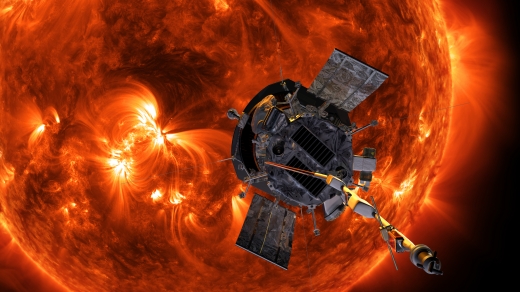
Image: Artist’s concept of the Parker Solar Probe spacecraft approaching the sun. The spacecraft will provide new data on solar activity and make critical contributions to our ability to forecast major space-weather events that impact life on Earth. Credit: NASA/JHU/APL.
After the Parker Solar Probe’s close pass, the spacecraft has gone nearer the Sun than any other craft. The Helios B probe was the previous recorder holder, setting the mark back in 1976. Helios B reached perihelion in April of 1976 at a distance of 43.4 million kilometers (26.9 million miles), inside the orbit of Mercury. A record the Parker probe surpassed with ease.
And the good news about Parker, reflected in the faces in the image below, is that the craft handled the heat and solar radiation without damage. Four status beacon signals are available, the best being the A signal that was received by mission controllers at JHU/APL on the late afternoon of November 7. Our latest mission to the Sun is live and collecting data.
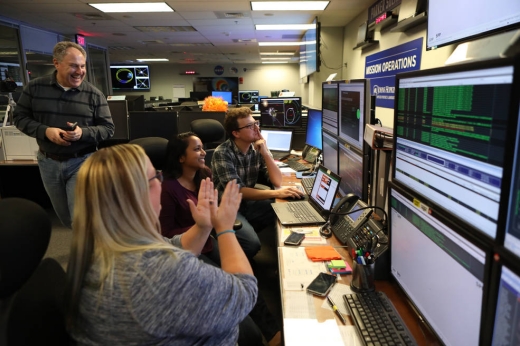
Image: Members of the Parker Solar Probe mission team celebrate on Nov. 7, 2018, after receiving a beacon indicating the spacecraft is in good health following its first perihelion. Credit: NASA/Johns Hopkins APL/Ed Whitman.
Parker is also setting speed records. Again we turn to Helios-B as the previous record-holder, at 70.2 km/s (157,078 mph). At perihelion on November 7, the Parker spacecraft reached 213,200 miles per hour, or 95.3 kilometers per second. By way of comparison, Voyager 1 moves at approximately 17 kilometers per second as it continues to push into interstellar space. Still in the heliosheath, sister spacecraft Voyager 2 is at a slightly more sedate 15.4 km/sec.
But back to the Parker Solar Probe, whose Sun-facing Thermal Protection System, an 11-centimeter thick carbon-carbon composite shield, reached about 820 degrees Fahrenheit, or 437 degrees Celsius. This is just the beginning, for the spacecraft will continue making closer and closer approaches in the course of its 7-year mission. 24 passes by the Sun are anticipated. The spacecraft will eventually close to a scorching 6.2 million kilometers from our star.
Deep space implications? The Parker Solar Probe’s findings will teach us much about the plasma flow leaving the Sun, a solar ‘wind’ that may offer future magnetic sails (magsails) one option for reaching high velocities within the Solar System (though we first must determine whether this highly variable flow can be efficiently exploited by future magsail designs).
The other implication is using a close solar pass in a ‘sundiver’ mission, accelerating a large payload that would be flung outbound in a spectacular gravitational assist, reaching velocities in the hundreds of kilometers per second. We’ll gain a great deal of knowledge about operations close to the Sun through the performance of Parker’s heat shield, all of which should be helpful if we do decide to explore sundiver options for reaching into the Kuiper Belt and beyond.

by Paul Gilster | Nov 8, 2018 | Exoplanetary Science |
We’ve long been interested in how the Earth got its oceans, with possible purveyors being comets and asteroids. The idea trades on the numerous impacts that occurred particularly during the Late Heavy Bombardment some 4.1 to 3.8 billion years ago. Tuning up our understanding of water delivery is important not only for our view of our planet’s development but for its implications in exoplanet systems with a variety of different initial conditions.
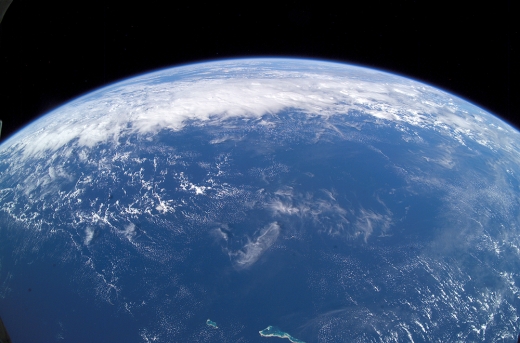
Image: This view of Earth’s horizon was taken by an Expedition 7 crewmember onboard the International Space Station, using a wide-angle lens while the Station was over the Pacific Ocean. Credit: NASA.
But the picture becomes more complex when we compare regular hydrogen atoms (one proton, one electron) with ‘heavy hydrogen,’ or deuterium atoms. The latter have a neutron in addition to a proton in the nucleus. A recent paper in the Journal of Geophysical Research digs into isotope ratios, the ratio of deuterium to ordinary hydrogen atoms, commonly referred to as the D/H ratio. One reason asteroids are favored by some scientists as the likely source of the bulk of Earth’s water is that asteroidal water has a D/H in the neighborhood of 140 parts per million. Contrast that with cometary water, which runs from 150 ppm to as high as 300 ppm.
When we examine Earth’s oceans, we find a D/H ratio close to that found in asteroids. The new study, from Jun Wu and colleagues at the School of Molecular Sciences and School of Earth and Space Exploration at Arizona State University, takes aim at the asteroid explanation, not by way of discounting it but rather of finding other sources making a contribution to Earth’s water.
“It’s a bit of a blind spot in the community,” said ASU’s Steven Desch, a co-author of the new study. “When people measure the [deuterium-to-hydrogen] ratio in ocean water and they see that it is pretty close to what we see in asteroids, it was always easy to believe it all came from asteroids.”
We are learning, however, that too uncritical an acceptance of D/H ratios may oversimplify the issue. For the hydrogen in Earth’s oceans is not necessarily representative of hydrogen deeper inside the planet, where D/H ratios close to the boundary between the core and mantle show considerably less deuterium. This may indicate a non-asteroidal source for at least some of the hydrogen.
Another telling point is that helium and neon, showing isotopic signatures inherited from the original solar nebula, have also been found in Earth’s mantle. Contrasting hydrogen at the core-mantle boundary with what we see in Earth’s oceans and factoring in these noble gases may change our thinking. The Wu study considers the formation of the planets in the earliest days of the Solar System, when small, often colliding planetary embryos up to the size of Mars went through gradual planetary accretion.
The new model works like this: As larger embryos formed largely from water-laden asteroids, they began to develop into planets. On Earth, decaying radioactive elements melted iron within the emerging world, pulling in asteroidal hydrogen and sinking to form a core. Collisions among planetesimals would meanwhile have created enough energy to melt the surfaces of the larger embryos like the Earth into magma oceans.
Hydrogen and noble gases from the solar nebula would be drawn in to create an early atmosphere. The nebular hydrogen, lighter than asteroidal hydrogen, would have dissolved into the molten iron of the magma ocean, eventually being drawn into the mantle, along with hydrogen from other sources.
What the authors argue is that this process created a slight enrichment of hydrogen in the molten iron and left a higher ratio of deuterium behind in the magma (the process is called isotopic fractionation). Hydrogen is attracted to iron, while the heavier isotope, deuterium, less attracted to iron, would have remained in the magma which would eventually become Earth’s mantle. We would end up with lower D/H ratios in the core than in the mantle and oceans. The authors argue that while most of Earth’s water is asteroidal, some of it did in fact come from the solar nebula.
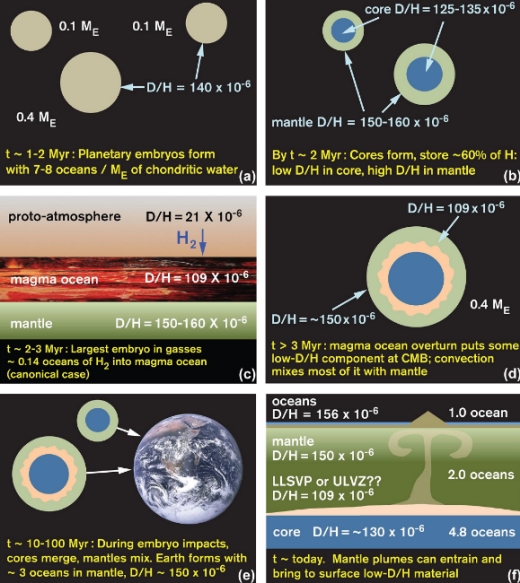
The process is complex, and also takes in impacts from smaller embryos and other objects that continued to add water and mass until Earth reached its final size. The authors provide this synopsis as their caption for Figure 1 (above), which I’ll reproduce verbatim but break into sections for reasons of readability:
- (a) Earth accreted from embryos with chondritic [asteroidal] levels of water concentrations and D/H ratios.
- (b) These embryos differentiated and stored relatively light hydrogen in their cores, raising the D/H of hydrogen in their mantles.
- (c) The largest embryo accreted a proto-atmosphere and sustained a magma ocean into which nebular hydrogen diffused.
- (d) The largest embryo’s magma ocean crystallized and overturned, mixing light hydrogen into the mantle, but incompletely.
- (e) As smaller embryos were accreted, their mantles joined the proto?Earth’s mantle, and their cores merged with the proto?Earth’s core.
The result is:
- (f) Earth’s mantle today contains approximately three oceans of water in its mantle and surface, with average D/H ? 150 × 10?6, and ~4.8 oceans’ worth of hydrogen in its core, with D/H ? 130 × 10?6. Mantle plumes can sample low?D/H material from the core?mantle boundary.
Wu says this: “For every 100 molecules of Earth’s water, there are one or two coming from [the] solar nebula.” But we now see the potential for including gas left over from the formation of our Solar System in the question of water delivery and accumulation. In other stellar systems where water-bearing asteroids may not be as abundant, this implies that water could still be in place from the system’s own stellar nebula. Wu adds: “This model suggests that the inevitable formation of water would likely occur on any sufficiently large rocky exoplanets in extrasolar systems. I think this is very exciting.”
The paper concludes:
Our comprehensive model for the origin of Earth’s water considers, for the first time, the effects of isotopic fractionation as hydrogen dissolved into metal and was sequestered into the core. Based on the behaviors of proxies, we consider it likely that the D/H ratio of the core is ~10% lighter than the mantle. We hypothesize that Earth accreted a few to tens of oceans of water from chondrites, mostly carbonaceous chondrites. Drawing on the latest theories of planet formation, which argue for rapid (<2 Myr) formation of planetary embryos, we favor ingassing of a few tenths of an ocean of solar nebula hydrogen into the magma oceans of the embryos that formed Earth.
The paper is Wu et al., Journal of Geophysical Research: Planets 09 October 2018 (full text).













